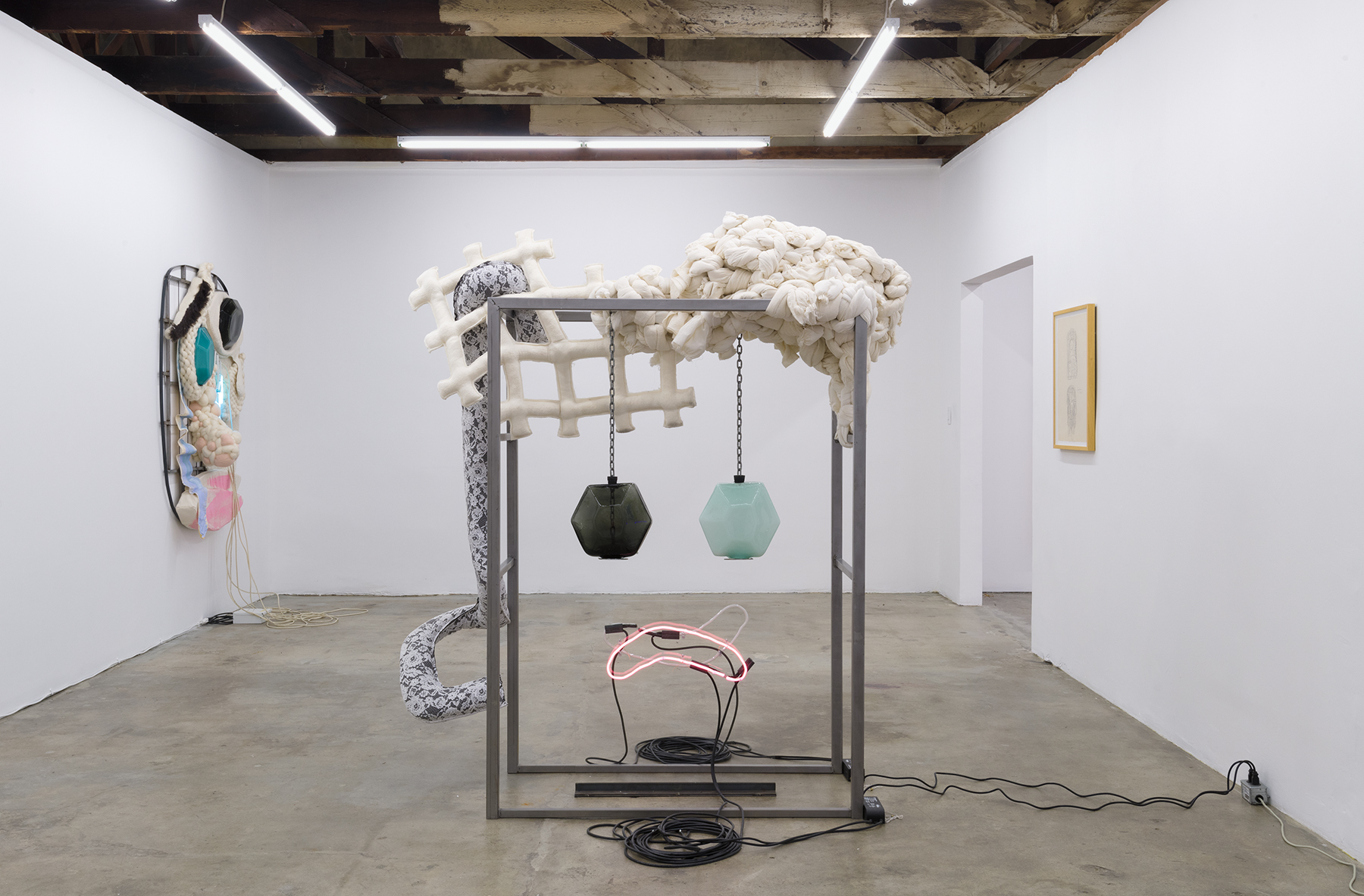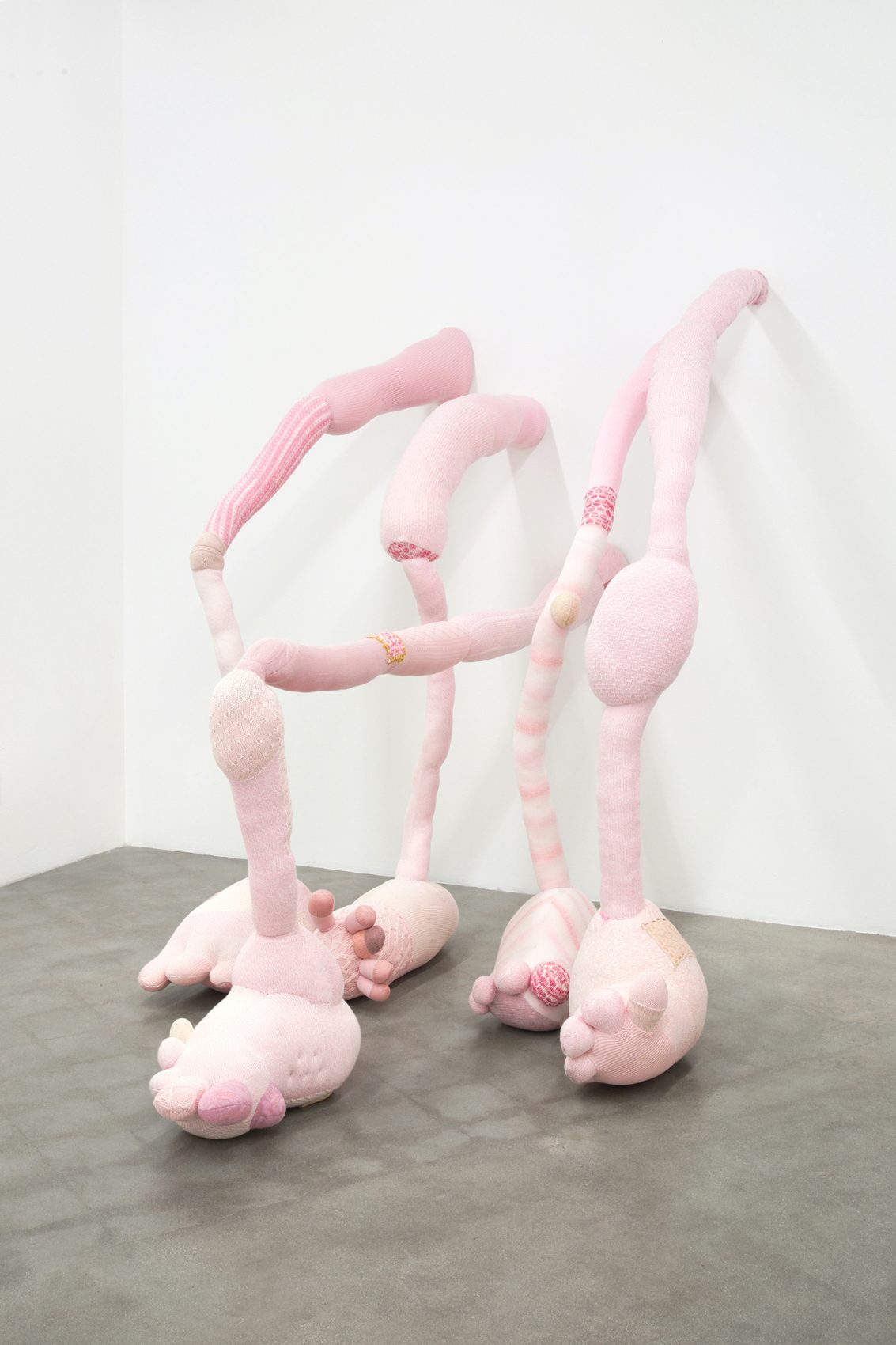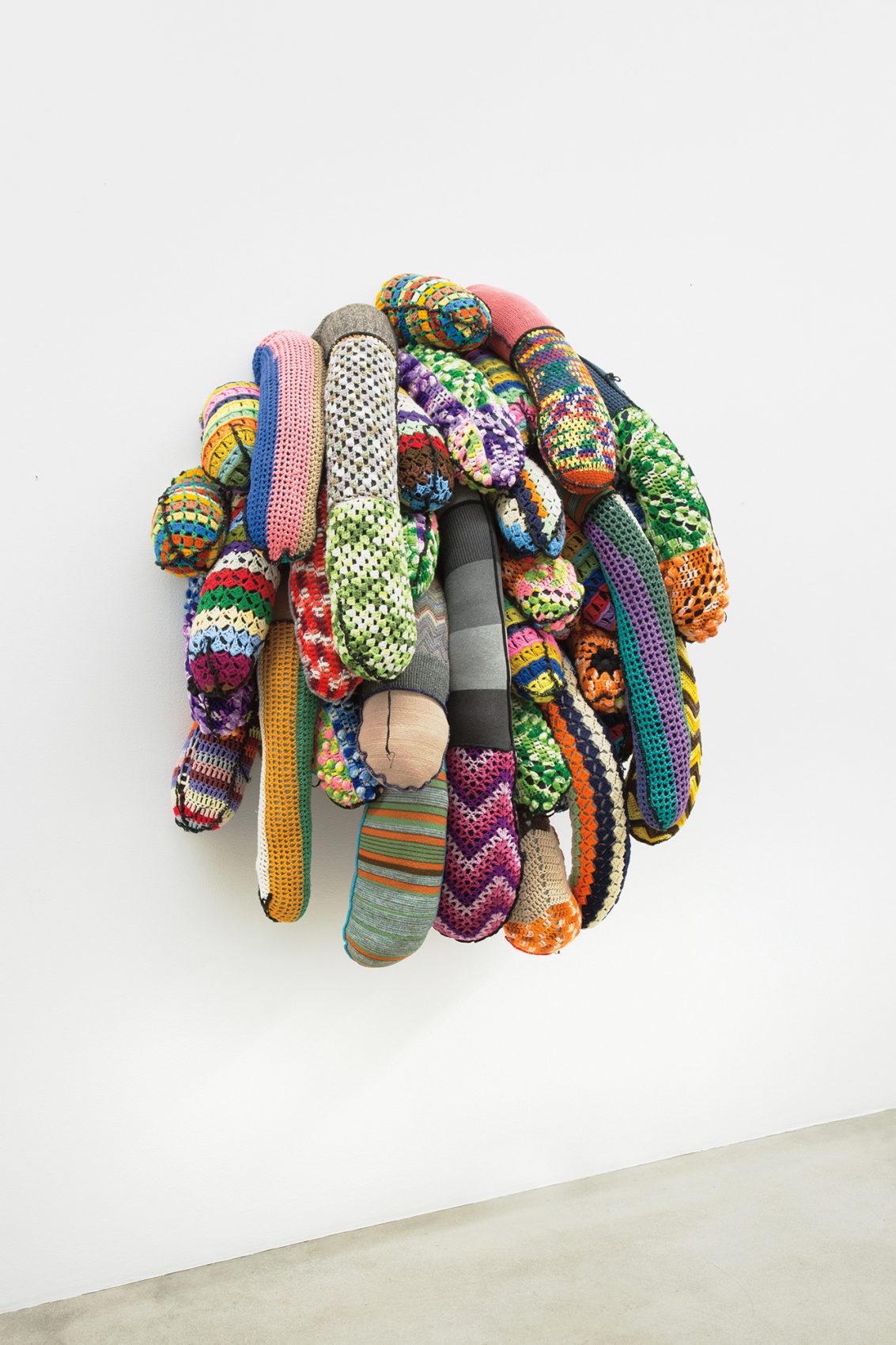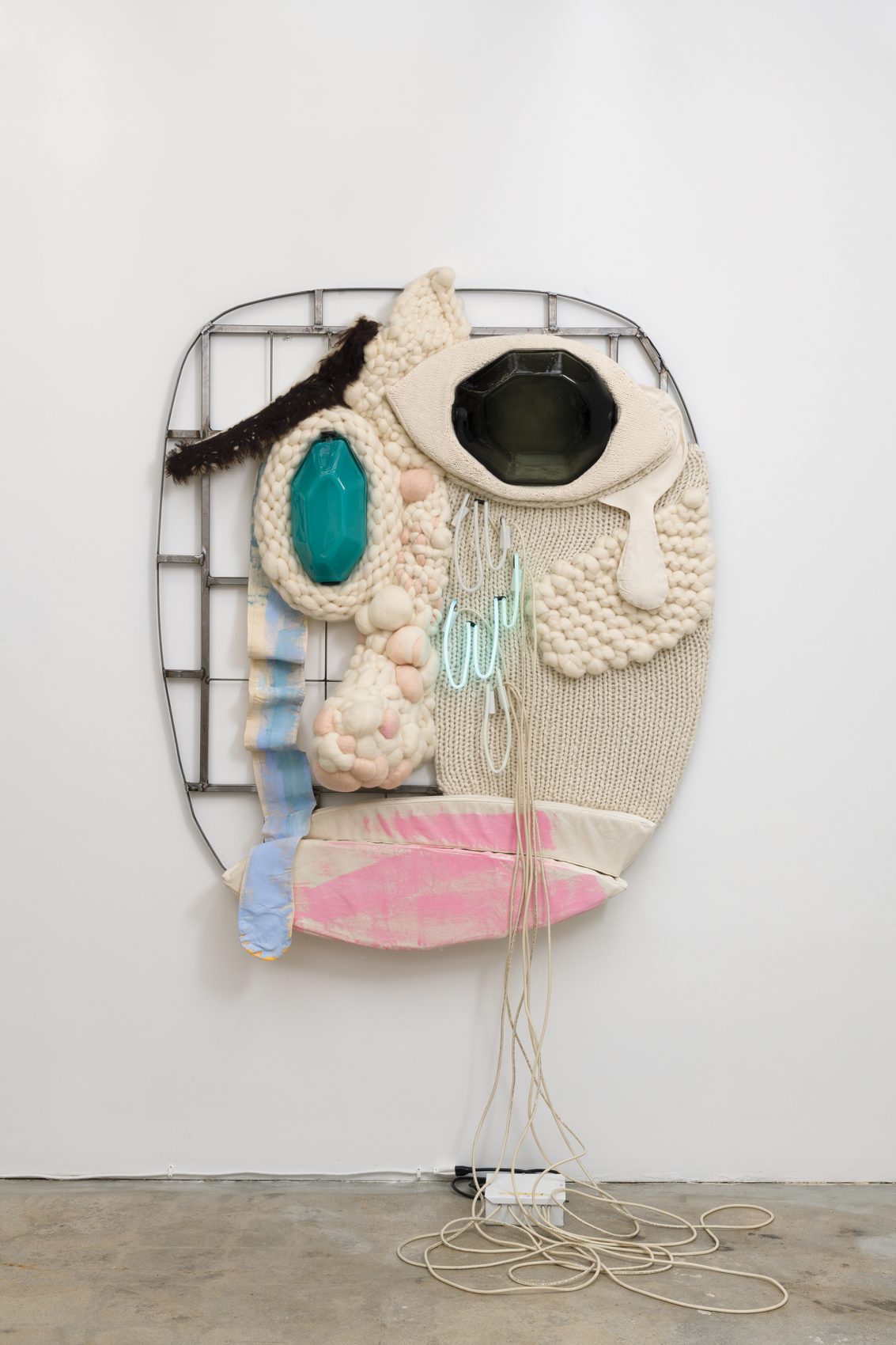About a mile south of downtown Los Angeles’s Arts District, cheap wholesale racks run ten feet deep from street curb to shop window. A store at East 4th and Wall Streets sells huge speakers that look like they walked out of 1992 en masse; turned on their sides, their cones make eyes at me, imploring a purchase. My favorite building in the vicinity is an old factory with a sign that reads “Blujeanious,” a bastardized portmanteau of “blue jean,” “genius,” and “delicious.” The superlative suffix hints at a confusion of feelings, one that haunts the miasma of twenty-first-century capitalism: blue jeans are neither “genius” nor “delicious,” but the process of buying and selling demands that a product take on human qualities to exchange its value effectively. It’s not hard to see where the late Miyoshi Barosh, a long-time Los Angeles resident, gleaned the inspiration for her wall reliefs and sculptures that use soft, chunky knits and gaudy thrift store lace to evoke bodies—faces, breasts, necks. Large appendages swing from her canvasses, upholstered in bright pink and purple chevron scarves. It’s not always pretty, but that may be the point. In some of the works at Night Gallery in downtown Los Angeles, I imagine each large-scale wall relief to be the tempered result of Louise Bourgeois huffing glue in a yarn shop. Explosions of paisley, tactile rainbows, and braided rope run floor to ceiling, mixing craftwork aesthetics with darker implications of American consumer culture and body politics. In Barosh’s world, the commodity is collaged, made human, and mocked. Her work trawls the depths of American culture and the feelings that often come with it, combining to form a chaotic, exuberant genre that encompasses the vast range of emotions demanded of the buyer, the seller, and the object for sale. Miyoshi Barosh’s paintings and sculptures go to the freak show, the shopping mall, and the chat room, revealing the trenchant discord within the outwardly stable structures of contemporary consumerism.

Miyoshi Barosh, LOVE, 2007. Found afghans, knitted fabric, yarn, pom-poms on canvas, 100 × 114 × 10 in. Installation view, MIYOSHI BAROSH: LOVE, Luis De Jesus Los Angeles, Culver City, January 11–February 22, 2020. © Estate of Miyoshi Barosh. Image courtesy of Luis De Jesus Los Angeles. Photo: Michael Underwood.
Barosh’s varied body of work mirrors the place she called home. She had developed a cultish following in Los Angeles for her colorful meditations on craftwork and accumulation, formulating a genre the artist playfully dubbed “Conceptual Pop.”1 Barosh’s death in 2019 of uterine cancer, at age fifty-nine, triggered new reflections on her diverse body of work. In January and February 2020, three shows in Los Angeles honored the artist’s life and work. At Luis De Jesus in Culver City, MIYOSHI BAROSH: LOVE displayed a collection of the large-scale tactile paintings-in-knit Barosh was known for, alongside a quintet of never-before-exhibited three-dimensional glass works sculpted to look like flesh. Glendale’s The Pit showed later works—sculptures that incorporated neon lights and bulbous appendages; one spelled out The End in blocky chenille yarn. Finally, Night Gallery exhibited a group of pieces that included everything from the artist’s wall-based textiles to her comedic riffs on internet culture. The three galleries are at opposing vertices of the city, requiring dedicated viewers to traverse freeways and side streets to pay their respects. Taken collectively, the shows are defined not only by what is contained within each gallery’s walls but also by the myriad, wandering paths between them, forming a transient memorial-in-motion to Barosh’s distinct legacy.
The majority of Barosh’s work uses a complex amalgam of textiles, from more basic loops of white braided yarn to patterns that recall American quilting practices and hand-sewn, frilled skirts and dresses. At Luis De Jesus, a tapestry entitled LOVE (2007) covers nearly an entire wall of the gallery. Its rich combine of colors and textures mixes psychedelic black-and-white paisley with the kitschy childhood crochet reminiscent of Barosh’s prominent Angeleno forebear, Mike Kelley. Visible stitches and hand-knit patterns complement the recycled afghans, scarves, and sweaters that make up the topographies of Barosh’s wall reliefs, including LOVE. Her signature handmade accents and bespoke fabrics place the historic craftwork of women in the white-walled space of contemporary art. This appropriative mode also defines a prior fringe movement from the 1970s and 1980s, Pattern and Decoration, which has enjoyed a recent renaissance in exhibitions across the globe. Critic Glenn Adamson notes, “Pattern and Decoration artists saw the history of women’s work—particularly domestic crafts—as a forgotten canon that could be reclaimed as a source of contemporary expression.”2 The artists of this movement are kindred spirits for Barosh; as Molly Warnock writes for Artforum, “[Pattern and Decoration artists] eschewed cool industrial surfaces . . . for a staggering panoply of craft processes, globally sourced motifs, and vibrant colors.”3 Pattern and Decoration combated the marginalization of “decorative art” in institutions by using craftwork techniques historically done in the home without wages, seeking to legitimize domestic “women’s work” and destabilize notions of high art that awarded monetary value to the pursuits of white men. The hard-edged masculinity of the avant-garde—especially of Minimalism—obscured artistic production under the auspices of the factory, twentieth century industry, and blue collar work. What Barosh calls her “handmade carnivalesque” technique engages with the feminist labor histories that define Pattern and Decoration—Minimalism’s fraternal twin—and enthusiastically embraces a legacy of craftwork that remains marginalized by museums and galleries.

Miyoshi Barosh, Receiving/Leaving, 2015. Steel, glass, Plexiglas, neon, fabric, 78 × 68 × 32 in. Installation view, Miyoshi Barosh, The Pit, Glendale, January 12–February 22, 2020. Image courtesy of The Pit and the Estate of Miyoshi Barosh. Photo: Jeff McLane.
In addition to recycled domestic fabric, Barosh readily incorporates mass produced objects into her assemblages of American consumer culture. Barosh’s smuggling of commodities from the commercial mainstream market into the realm of high art recalls the strategies of Pop art along with newer appropriative modes adopted by Barosh’s contemporaries, such as Lauren Halsey, Tomashi Jackson, and Jason Rhoades. Barosh’s Conceptual Pop weds her lineage to Pop art’s while situating her own fantastical assemblages within newer discourses. Pop art encapsulated the emergence of a postwar consumer culture and its consequent articulation in galleries and museums; as Benjamin H. D. Buchloh notes, the rise of Fordist manufacturing and advertising in midcentury America consolidated “an oppressively stable, monolithically industrial, capitalist civilization . . . [creating] conditions in which mass culture and high art would be forced into an increasingly tight embrace.”4 Barosh’s art of accumulation situates the commodity object at the center of her work, from smooth steel armatures to plastics and chemical lighting. Receiving/Leaving (2015) at The Pit mixes metal armature, pastel plastic, and neon with a lace appendage and a mass of chunky, white knitted spools. The sculpture is a conglomerate of readily available, machine-made material and hand-stitched fabric. Two links of chain dangling from the top of the structure hold a smoothly cut, factory-made green jewel and two bent neon ovals meant to resemble “happy” and “sad” faces. Her work negotiates a space in between Andy Warhol’s Coke bottle, which Buchloh describes as “cold and diagrammatic,” and the maximalist approach of her Pattern and Decoration forebears, embracing the overwhelming plethora of signifiers available in mass culture.5 Of the “postproduction” of twenty-first-century artists, Nicholas Bourriaud writes that the recycled signifier constitutes a new movement that goes far beyond the appropriative mode espoused in Pop art, championing a “recourse to already produced forms . . . [testifying] to a willingness to inscribe the work of art within a network of signs and significations, instead of considering it an autonomous or original form.”6 The works of these contemporary artists—from Lauren Halsey’s neighborhood commodity installations, which Halsey calls “South Central L.A. business taxidermy,” to the colorful composite easels of Tomashi Jackson—disavow the modern art object’s autonomy in favor of production and consumption practices that reflect the experiences and activities of the twenty-first century.7 Barosh’s homage to craftwork is matched with equal attention to the highly circulated commodities that lace contemporary life from the screen to the street, rejecting artistic autonomy for the endless circulation of objects and texts in the realm of “high” art.
Barosh’s work organizes around an affective relationship between the consumer and the commodity, an exploration of the emotional underpinnings of capitalism. Many of her sketches and sculptures take on a voice that addresses the viewer directly, as though each assemblage were a person speaking to a unique audience. The words and feelings that emanate from her work often use the trite maxims of internet emotion-speak: at Luis De Jesus, a pencil sketch reads, “I FEEL BETTER EVERY DAY” in a comic bubble-letter typeface; another mock-up, at The Pit, asks the viewer, “WHAT IS YOUR EMOTIONAL STATE TODAY?” In Barosh’s work, the art object asks each witness to attribute it human qualities and consider its feelings. Theorist Walter Benjamin often explored the complicated ways in which buyers relate to the “feelings” of the objects they desire, noting Karl Marx’s use of the “commodity-soul.” As Benjamin remarks, “If the soul Marx occasionally mentions existed, it would be the most empathetic ever encountered in the realm of souls, for it would have to see in everyone the buyer in whose hand and house it wants to nestle.”8 Barosh’s later sculptures at The Pit collage bent neon, knitted patterns, and plastic gems to form faces, using recycled commodities to call to their viewer, gaze at her, and provoke feeling. Each neon curve bends upward or downward into an emoji-like happy or sad face and lights up at alternating intervals. (When I visited, they were all “sad.”) Barosh projects feeling onto an overworked commercial symbol: the neon sign, which is lodged in the collective imaginary in the form of an “OPEN” or “CLOSED” placard, designating certain spaces as points of capital exchange. Here, neon morphs into a pitiful emotional display, making visible the affective strategies that fuel mass culture. Barosh’s sculptures smile and frown, an amalgam of mass-produced and handmade objects that gather to embody a speaker, a commodity-form that anticipates, seeks, and feels its viewer.

Miyoshi Barosh, Study for FEEL BETTER, 2007. Graphite on paper, 9 × 12 in. © Estate of Miyoshi Barosh. Image courtesy of Luis De Jesus Los Angeles.
The emotional structure that braces Barosh’s craftwork-cum-capitalist aesthetic is highly specific, implying a feminized and “cute” system of mass production meant to engage shoppers’ problematic affective tendencies. Writing on the aesthetic of “cuteness,” historian Lori Merish defines the “cute object” as “usually designated by roundness of form and thickness of limbs; roundness and flatness of face; largeness of eyes; and especially by largeness of head in proportion to the body.”9 At Night Gallery, most of the sculptures conform to this category. In one wall-relief, entitled Large Legs (2014), enormous soft pink limbs emerge from the wall. Each is covered in a knit textile that culminates in oblong feet and tiny, curved toes. The legs are infantile, the feet even more so—as though dressed in childish footed pajamas or fluffy socks. Merish notes that the powerlessness ascribed to the cute object “always in some sense designates a commodity in search of its mother . . . grafting commodity desire onto a middle-class structure of familial, expressly maternal desire.”10 The loosely articulated face of Untitled (Sad Round Head) (2017), at The Pit, relies on characteristics of the cute: roundness of form, two enormous eyes adorned with haptic coils of chunky white yarn, pink lips, and lit-up neon blue tears. The socially ascribed femininity of Barosh’s patchwork quilts and homemade knits furthers the metaphor, with each painting resembling a blanket that could soothe the viewer and keep her “cozy.” Cuteness replicates and reaffirms the dominance of the commodity’s owner while ensuring the enticing relationship between object and person, a sentimental emotion that propels a purchase. The feeling projected by Barosh’s characters, in their speech or their form, is one of helplessness and despair, a performance of extreme vulnerability that can only be assuaged by the buyer. Barosh’s suggestion of feminized, maternal “cuteness” in her artwork implicates viewers, collectors, galleries, and artists in the ever-tighter “embrace” of “mass culture and high art,” one that necessarily holds darker allegiances to a patriarchal obsession with powerlessness.11

Miyoshi Barosh, Large Legs, 2014. Polyester, cotton, wool knit fabric, found sweater knits, and poly filling, 91 × 74 × 103 in. Installation view, MIYOSHI BAROSH, Night Gallery, Los Angeles, January 11–February 8, 2020. © Estate of Miyoshi Barosh. Image courtesy of Night Gallery.
But Barosh’s “cute” is shot through with violence and injury, conjuring characters and images that suggest the complicated underbelly of the relationships that entwine American consumerism. Cultural theorist Sianne Ngai notes that most cute objects are both “helpless and aggressive,” a “paradoxical doubleness . . . embedded in the concept of the cute from the start.”12 The ways in which Barosh’s artwork becomes “aggressive” pushes the boundaries of the cute, often arousing feelings of disturbance or revulsion before those of the maternal and caring. For all of Barosh’s exuberance and her enthusiastic espousal of domestic craftwork and rich patterns, a bodily grotesque lurks within the artist’s sculptures, drawings, and wall reliefs, refusing, at least partially, the feminization of “cute” objects in the marketplace. In Soft Intervention (2014) at Night Gallery, colorfully knit tubes clothe a plethora of phallic appendages. While the cute always in some way resembles the human body, usually the body of an infant, Barosh steps over the line that the aesthetic carefully toes. Here, Barosh puts a patriarchal symbol of power at the center of the commodity’s construction, disavowing the perceived helplessness of the feminized object and attributing vulnerability to the masculine member. The taboo of adult anatomy, combined with Barosh’s cozy, domestic knits, pairs the cuteified world of twenty-first-century consumer culture with an uncanny, and therefore revolting, body-double. What Barosh mirrors in a world of Hello Kitty and personalized Instagram advertising is always matched with an underlying threat, either through the repulsion aroused by overt phallic symbols or by the literal insinuation of injury. In Large Legs (2014), small square bandages cover each limb, with sections of knitting partially unraveled. Injury embeds itself within the material of the work—faux gauze is knit from the same yarn as each leg, for example—as though the potential for pain were buried in the commodity object from the start. The co-presence of injury and cuteness is common: as writer Daniel Harris remarks, “The cute . . . gets cuter when maimed or hobbled.”13 The perception of injury designates an object in need of a customer’s care, much like the “soft, rounded” shapes that make the product resemble a baby or a small animal. Barosh’s viewer cannot rest, shoved into spaces that demand a confusion of emotional responses. Her artwork interpolates the commodity with the body beyond comfort, pushing the cute into the territory of the abject, the grotesque, and the pained.

Miyoshi Barosh, Soft Intervention, 2014. Found afghans, sweaters, polyfill, 60 × 58 × 22 in. Installation view, MIYOSHI BAROSH, Night Gallery, Los Angeles, January 11–February 8, 2020. © Estate of Miyoshi Barosh. Image courtesy of Night Gallery.
Though Barosh’s work gestures toward a panoply of feeling that runs the gamut of consumer culture—from pity to desire to revulsion—part of her art’s mystery is the surprising confusion of affects it produces, as though each feeling has been dismembered from its original intentions. The moment where feeling is exchanged between object and consumer is one of the trademarks of the “cute” and the place where Barosh’s work departs. When an adult sees a baby, for example, the adult feels compelled to speak in an infant’s voice, a mimicry of powerlessness that reifies the power differential between the pair while placing an affective demand on the adult actor.14 In Barosh’s work, the provocation of coherent feeling is absent: at Luis De Jesus, the eponymously named knit tapestry bears the word LOVE in black-and-white paisley bubble letters. What is conjured in the viewing of the tapestry is not love but something close to love’s commodity-form, a “love” birthed from time-bound culture over a universal, timeless feeling: see the fifties Missoni chevron, the sixties paisley, the seventies prairie afghans. Untitled (Sad Round Head) is pitiful, but unsuccessfully so: its sad painted mouth, neon tears, and large, forlorn green eyes do nothing to evoke the pity of the watcher. The bandages on Large Legs make the limbs appear hurt, but, separated from a body or a face, they are not human enough to make us want to care for them. The objects’ humanlike qualities are interrupted by a calculated and obvious use of material, from the hard, factory-made plastics of the faces at The Pit to the quilted paisley tapestry at Luis De Jesus. Flesh is far away; metal, polyurethane, and cheap rayon lie closer. Barosh breaks cuteness in half: her maximalist displays of American material culture confuse the emotional world of consumerism, staging a self-conscious intervention on the fraught feelings provoked and produced under capitalism.

Miyoshi Barosh, Untitled (Sad Round Head), 2017. Steel, glass, neon, fabric, 64 × 54 × 12 in. Installation view, Miyoshi Barosh, The Pit, Glendale, January 12–February 22, 2020. Image courtesy of The Pit and the Estate of Miyoshi Barosh. Photo: Jeff McLane.
After three shows, I find Miyoshi Barosh everywhere: in thrift stores in Echo Park, the junk store on La Brea, my car, my house, my body. Her work has the paralyzing effect of infinite appropriation, a “post-production” that mingles the corporeal with the mass- produced and the handmade. The cuteness that defines much of the relationship between consumer and commodity is winked at—and then destroyed. Barosh approximates the body as seen through a shop window or a circus tent: her anthropomorphized assemblages of objects call to us like sirens. We’re shopping always, whether we like it or not, in the street, in the gallery, and on the internet. As much as Barosh’s work appears to be a monument to American surfaces—with their craftwork nostalgia and neon pleas—I left all three shows feeling empty, divorced from reaction. Around me lay a thousand storefronts, clothes, and toys. There’s a catharsis promised to shoppers, the respite from desire and the consequent thrill of possession. Of all the feelings Barosh gestures toward, she is most critical of this one. The emotions promised under mass consumption wind up in Barosh’s artistic graveyard, a mausoleum of misplaced and misguided affective debris, the final resting place of consumerism. For all her pizzazz, Barosh’s colorful, maximalist takes on contemporary life are ghosts of our relationship to the shit we fill our lives with, disembodied and mashed together, bloated by empty flesh. Thank God she was so nice about it.
Claudia Ross is a writer in Los Angeles.
